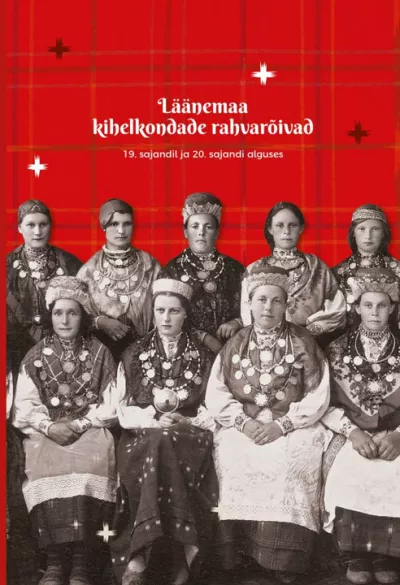General information
RDP Priority
- P6. Social inclusion and local development
RDP Focus Area
- 6B: Local development
RDP Measure
- M19: LEADER/CLLD
Beneficiary type
- Local Action Group
Summary
One of the most valued strengths of Kodukant Läänemaa's region, in western Estonia, is its diverse and rich cultural heritage. The area’s heritage has been influenced by different periods and nations throughout time. This project aimed to enable managers and operators of small museums to skillfully present this heritage while also developing their visitor attraction as a rural business.
Results
- This project increased the visibility of the museums operating in the region and the quality of the exhibitions and services offered.
- The participants formed a functioning and supportive network that offers help with practical matters and keeps everyone motivated.
- A wide variety of folk clothes and other accessories have been preserved in the form of photos published in a book.

Promoter
NGO Kodukant Läänemaa (LAG)
Funding
Total budget: 44 880 (EUR)
EAFRD: 32 314 (EUR)
National/Regional: 8 078 (EUR)
Private: 4 488 (EUR)
Topics
Resources
Documents
Good Practice Report - Promoting the cultural heritage of Western Estonia through the skillful work of local people
(PDF – 4.11 MB)
Context
While drafting the Kodukant Läänemaa LEADER local development strategy, it became clear that cultural and historical heritage is a main strength of this LAG region. The strategy identified a need to improve the way that local heritage is presented. It was an unused potential source of income that could be developed into an important tourism service across the region. The target group of the project was mainly managers and volunteer workers of small museums of the region. Small museums are mostly owned by non-profit organisations or local governments. Employees of small museums, especially in the case of NGOs, lacked appropriate training. There was no knowledge of the creation and presentation of exhibitions, museum pedagogy and other skills necessary for running a heritage attraction.
In addition, the transmission of cultural heritage skills and practices from one generation to the next is in decline. Folk costumes and their differences from region to region play an important role in Estonian cultural heritage. The number of people who have the skills to identify these differences, or who have knowledge about the specifics of folk costumes, is rather narrow. In order to pass on this heritage knowledge, the project involved a wider target group across different age groups, and the research they undertook together culminated in the publication of a book, which involved many local people, museum workers and community leaders, as well as specialists at the national level.
Objectives
The aim of this project was to improve rural skills of local people in preserving and promoting cultural heritage and improving regional tourism offers.
Activities
Activities implemented included:
- Organising a public discussion about the preparation of the Läänemaa folk costume book (07/04/2018).
- Organising a study tour of small museums in Estonia (28-29/09/2018).
- Developing a staff training programme for small-scale museums on how to plan and organise cultural heritage events:
- First study module: museum pedagogy and its role in the daily life of the museum (01/12/2018).
- Second study module: the use of tradition in event management (19/01/2019).
- Third study module: the ABC of making an exhibition, from the initial idea to the finished project (16/02/2019).
- Fourth study module: highlight events in museums (23/03/2019).
- Organising a study visit and training in Swedish museums (09 and 14/09/2019).
- Organising a photography workshop for cultural heritage custodians (15/11/2019).
- Organising a 'Heritage Day' event and book presentation, which included a presentation on folk costumes (26/09/2020).
The project involved employees and owners of private, community led and public (local municipality) museums, managers of heritage and natural objects, home history researchers and community leaders.
Main results
- Participants in the training programme can better organise heritage events and exhibitions, involving their local community in the preparatory work.
- The small museums added new items to their exhibitions and improved their visitor experience.
- The book 'The folk costumes of Läänemaa parishes' in the 19th century and the beginning of the 20th century' presents items from across the region and was the result of a collaborative community effort.
- The revenue of small museums in the region is increasing.
Key lessons
- Above all, the project team learned that engaging a critical mass is important to achieving results. If the number of relevant stakeholders involved is small, the results will also be limited. To achieve the results, a so-called snowball method was used to expand the number of participants.
- It was also confirmed that collecting feedback from the participants after each event is essential to maintain momentum and build a trusting relationship. This helps to ensure the sustainability of the project results and the creation of possible new collaborations in the post-project period.
- It is important to maintain a personal approach to create a trusting relationship that promotes sharing knowledge and information. For example, it was important to clarify that collecting items for the book did not mean taking items away, but that they were photographed and preserved. As a result, people were more willing to share items for temporary exhibitions or to display folk costumes at events.
- It is necessary to think about how those who participated in the project could share what they have learned and experienced, and what additional activities might maintain and actively grow the network that has been created.
- For the project to be sustainable, work should be done in the early stages to establish a local leader who can ensure the independence of actors.
Liis Moor

